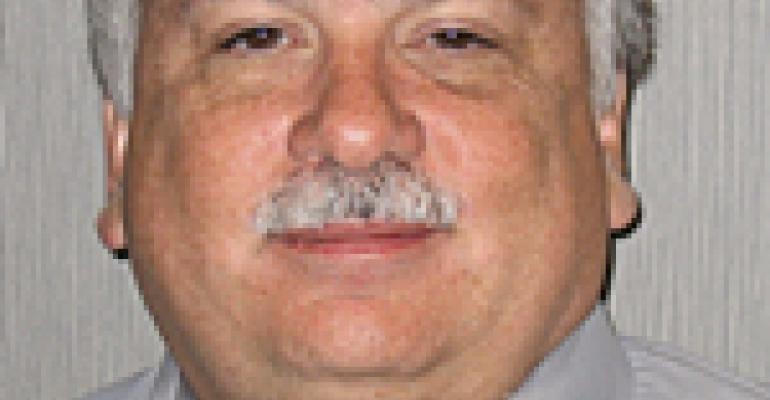Name:David A. Snyder
Title:director of information technology, or IT, Del Taco, Lake Forest, Calif.
Birth date:March 10, 1955
Education:associate of arts degree, computer science, Control Data Institute; also attended University of California at Irvine
Career:formally joined Del Taco in early 2007 after working as a consultant since 1999 on Y2K and other projects; previously provided IT consulting services to variety of clients and, for 10 years, operated a tax software company
Manages:15 employees
Reports to:Shirlene Lopez, president and chief operating officer
Family:married, with two grown children
Pastimes:watching auto-racing, horse-racing tournaments
POS system:Radiant/Aloha point-of-sale system hardware and software
Unit-level, back-office application:in-house developed software called UltraBOS
Enterprise accounting and human resources applications:Microsoft Dynamics GP (formerly Great Plains)
Other applications: XcelleNet polling software; custom-developed software for cash reconciliation, food management, employee time keeping, risk management, customer comment line, quality assurance and electronic invoicing
New Del Taco director of information technology David A. Snyder knows it isn't always easy to convince decision makers to invest in IT projects. But to make that job easier, he indicates, he creates a laboratory-style environment where executives can see applications or hardware in action and then follows up such demonstrations with in-restaurant pilot tests.
Also important to greasing the project-approval skids, according to Snyder, is having "an exit strategy available in the event the promised benefits of the technology do not materialize as promised during the pilot."
Snyder was named to his post earlier this year after previous IT executive Henry Volkmann left to pursue other interests, according to sources at Del Taco, which operates or franchises to others 493 quick-service Mexican restaurants in 14 states.
When it comes to selling operators on IT initiatives, Snyder says, building a two-way street "where you listen and respond to their needs and vice versa" is critical. End-users "will be a lot more positive regarding what you're trying to do for them now if they feel you have adequately addressed their needs in the past," he observes.
What are some of Del Taco's current IT projects?
[The] ongoing rollout of the Radiant/Aloha POS platform; implementing POS-based gift-card and shopper-survey programs; [and] deploying Microsoft Dynamics GP business portal and self-serve human resources application.
How will Del Taco's approach to technology change now that you are IT director?
Two of the company's recently completed IT projects centered on laptop-oriented remote support of in-store technology and handheld terminals in the drive-thru lane. I believe our focus should now be on using technology to support the performance and tasks of restaurant personnel ... and enhance their job satisfaction. The areas for which I am most interested in using technology are employee training efforts and self-serve human resources activities.
What challenges do you anticipate facing as you move ahead on these two fronts?
Unfortunately, our restaurants do not have a lot of room for additional equipment. We will need to come up with a sufficiently compact solution to achieve our goal.
What's the most challenging and/or difficult but gratifying IT project you've handled in your restaurant career?
Implementing a state-of-the-art, broadband-enabled restaurant systems platform as a replacement for a DOS-based, non-networked restaurant system platform at over 300 locations was a huge undertaking that has gone surprisingly well for us. This effort has been underway for more than four years.
How did you see that challenge through to fruition?
The first phase involved the development of a custom Windows-based, back-office system that could seamlessly replace the existing DOS-based, back-office system. The second phase required a visit to every store location to convert existing file servers from DOS to Windows and implement the new back-office system. For the third phase, we engaged a network management company to replace the existing dial-up communications with broadband, using DSL and satellite technology. The fourth and final phase, which is still underway, required the replacement of an antiquated POS system with a state-of-the-art POS system.
Why was that initiative so challenging?
Replacing back-office systems, outdated file servers and antiquated POS systems on a limited budget at hundreds of remote locations without disrupting restaurant operations or corporate accounting functions can be a daunting task. The most daunting aspect of this project, and the most gratifying, was that it was done with limited resources over a longer period of time, as opposed to an accelerated implementation strategy over a shorter time period, which would have required significant resources from outside vendors at a likely prohibitive cost.
What do you think is the best technology innovation for restaurants to make its debut recently, and why?
The capability to take orders during peak times on a mobile device in the drive-thru lane and using wireless technology. It's a "win-win" for operators and customers.
What technology do you think the industry might be able to live without, and why?
Radio frequency identification (RFID) technology [contactless credit and debit cards] for purchases is likely to be more trouble than it's worth. I'm not convinced that it will be widely embraced by consumers given the potential for identity theft, and it would likely create privacy concerns that may require additional corporate-based resources to address.
What type of technology would you like to see developed for the industry?
Iwould love to see some sort of inexpensive, paper-thin digital media that could replace menu board translites and other point-of-purchase-related materials and could be updated remotely. That would be really cool to see in place at a restaurant.




